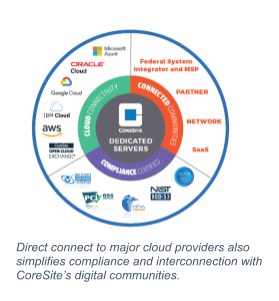
What is Cloud Direct Connect and 5 Key Advantages
I’m confident that your company either is or will soon be utilizing public cloud as part of its multi-cloud strategy. Why am I so sure? As vice president of network and interconnection, I frequently work with IT teams to think through what an optimal cloud and cloud services deployment looks like, and public cloud is almost always part of the vision. I also researched to get background for this post, I found a source that gave me several data points from 2020 that reinforce my confidence:
- 41% of enterprise workload will be run on public cloud platforms (Forbes)*
- By 2025, the amount of data stored on cloud servers will surpass 100 Zettabytes (Cybercrime Magazine)*
- Cost-cutting tops the list of the reasons why enterprises choose to adopt the cloud (Datometry)*
Cutting costs has always been a primary objective for cloud adoption. However, what many companies experience is that their data egress charges far exceed expectations. There’s a way to solve that problem: direct connect.
Direct connect is a dedicated, physical fiber interconnect to a cloud provider within a colocation facility. You’ll often see direct connect referred to as “native,” “on-net” or “onramp.” Regardless of what it’s called, it’s the fastest and most reliable avenue to your digital ecosystem and customers – and 60%-70% cost savings on data egress rates.**
There are more reasons to leverage direct cloud connection, including:
Security – As your infrastructure expands, so does the volume of attack vectors. Direct connect limits the points of network access and enables you to layer colocation provider security with third-party cybersecurity services. Of course, security dovetails with industry compliance; addressing HIPAA, ISO 27001, PCI DSS, NIST 800-53, and SOC 1 Type 2 and SOC 2 Type 2 compliance is streamlined.
Performance – The lowered latency speeds transferring large data sets for high performance computing. Application performance is optimized and consistent, so you can deliver a competitive customer experience. Direct connect also allows for frictionless migration of virtual machines between dev/test environments. That gives developers the performance they are looking for.
Reliability – Direct connect provides the high reliability of a private network. Combine that with CoreSite’s 100% uptime SLA and 24x7x365 remote hands service and always-on reliability is ensured.
Reduced Total Cost of Operations – In addition to data egress cost cutting, you can reduce bandwidth demand and associated network expenses. Further cost reductions are realized through connectivity enabled by Any2Exchange® (internet peering), the Open Cloud Exchange® (enterprise-class, automated one-to-many network services) and WAN virtualization. Put it all together and you have reduced total cost of operations (TCO).
Which Cloud Service Providers Are Available?

CoreSite has native onramps to all the major cloud service providers, which means you can take advantage of the services each offers that are relevant to your business requirements and aspirations. Here are links to each, so you can explore their solutions, services and pricing.
- AWS Direct Connect
- Microsoft Azure Express Route
- Google Cloud Platform
- Oracle FastConnect
- IBM Cloud® Direct Link
- Alibaba Express Connect
Why Is CoreSite Able to Offer Direct Connectivity?
CoreSite has direct connection with CSPs primarily for two reasons:
- Network density and services ecosystem – CSPs allows direct connection with CoreSite because of the 750+ service providers (including 450+ network providers) colocated in our data centers.
- Data center campus locations – With 30 data centers in 11 densely populated markets, CSPs recognize the advantages digital enterprises can realize by collocating in these regions, with interconnection to all campuses enabling access to regional availability zones.
If you are in the process of vetting potential colocation partners, be sure to ask each if they have the direct connection to the CSP you prefer.
How to Get Started
As I said at the top of this post, I often collaborate with customers to map out a multi-cloud strategy that’s tailored for their business operations and long-range infrastructure vision. The best first step is to contact us and get time on the calendar to discuss your business objectives, current state of digital transformation and timetable.
Together, we can determine how direct connection to public cloud can be integrated into your hybrid IT roadmap.










